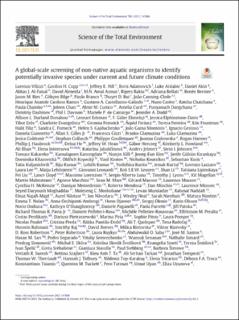| dc.contributor.author | Vilizzi, Lorenzo | |
| dc.contributor.author | Copp, Gordon H. | |
| dc.contributor.author | Hill, Jeffrey E. | |
| dc.contributor.author | Adamovich, Boris | |
| dc.contributor.author | Aislabie, Luke | |
| dc.contributor.author | Akin, Daniel | |
| dc.contributor.author | Al-Faisal, Abbas J. | |
| dc.contributor.author | Almeida, David | |
| dc.contributor.author | Azmai, M. N. Amal | |
| dc.contributor.author | Bakiu, Rigers | |
| dc.contributor.author | Bellati, Adriana | |
| dc.contributor.author | Bernier, Renee | |
| dc.contributor.author | Bies, Jason M. | |
| dc.contributor.author | Bilge, Gokcen | |
| dc.contributor.author | Branco, Paulo | |
| dc.contributor.author | Bui, , Thuyet D. | |
| dc.contributor.author | Canning-Clode, João | |
| dc.contributor.author | Cardoso Ramos, Henrique Anatole | |
| dc.contributor.author | Castellanos-Galindo, Gustavo A. | |
| dc.contributor.author | Castro, Nuno | |
| dc.contributor.author | Chaichana, Ratcha | |
| dc.contributor.author | Chainho, Paula | |
| dc.contributor.author | Chan, Joleen | |
| dc.contributor.author | Cunico, Almir M. | |
| dc.contributor.author | Curd, Amelia | |
| dc.contributor.author | Dangchana, Punyanuch | |
| dc.contributor.author | Dashinov, Dimitriy | |
| dc.contributor.author | Davison, Phil I. | |
| dc.contributor.author | de Camargo, Mariele P. | |
| dc.contributor.author | Dodd, Jennifer A. | |
| dc.contributor.author | Donahou, Allison L. Durland | |
| dc.contributor.author | Edsman, Lennart | |
| dc.contributor.author | Ekmekci, F. Guler | |
| dc.contributor.author | Elphinstone-Davis, Jessica | |
| dc.contributor.author | Erös, Tibor | |
| dc.contributor.author | Evangelista, Charlotte | |
| dc.contributor.author | Fenwick, Gemma | |
| dc.contributor.author | Ferincz, Arpad | |
| dc.contributor.author | Ferreira, Teresa | |
| dc.contributor.author | Feunteun, Eric | |
| dc.contributor.author | Filiz, Halit | |
| dc.contributor.author | Forneck, Sandra C. | |
| dc.contributor.author | Gajduchenko, Helen S. | |
| dc.contributor.author | Monteiro, Joao Gama | |
| dc.contributor.author | Gestoso, Ignacio | |
| dc.contributor.author | Giannetto, Daniela | |
| dc.contributor.author | Gilles, Allan S. | |
| dc.contributor.author | Gizzi, Francesca | |
| dc.contributor.author | Glamuzina, Branko | |
| dc.contributor.author | Glamuzina, Luka | |
| dc.contributor.author | Goldsmit, Jesica | |
| dc.contributor.author | Gollasch, Stephan | |
| dc.contributor.author | Goulletquer, Philippe | |
| dc.contributor.author | Grabowska, Joanna | |
| dc.contributor.author | Harmer, Rogan | |
| dc.contributor.author | Haubrock, Phillip J. | |
| dc.contributor.author | Hean, Jeffrey W. | |
| dc.contributor.author | Jelmert, Anders | |
| dc.contributor.author | Johnsen, Stein Ivar | |
| dc.contributor.author | Malmstrøm, Martin | |
| dc.contributor.author | Velle, Gaute | |
| dc.date.accessioned | 2022-02-16T14:03:29Z | |
| dc.date.available | 2022-02-16T14:03:29Z | |
| dc.date.created | 2022-02-11T11:01:05Z | |
| dc.date.issued | 2021 | |
| dc.identifier.issn | 0048-9697 | |
| dc.identifier.uri | https://hdl.handle.net/11250/2979446 | |
| dc.description.abstract | The threat posed by invasive non-native species worldwide requires a global approach to identify which introduced species are likely to pose an elevated risk of impact to native species and ecosystems. To inform policy, stakeholders and management decisions on global threats to aquatic ecosystems, 195 assessors representing 120 risk assessment areas across all six inhabited continents screened 819 non-native species from 15 groups of aquatic organisms (freshwater, brackish, marine plants and animals) using the Aquatic Species Invasiveness Screening Kit. This multi-lingual decision-support tool for the risk screening of aquatic organisms provides assessors with risk scores for a species under current and future climate change conditions that, following a statistically based calibration, permits the accurate classification of species into high-, medium- and low-risk categories under current and predicted climate conditions. The 1730 screenings undertaken encompassed wide geographical areas (regions, political entities, parts thereof, water bodies, river basins, lake drainage basins, and marine regions), which permitted thresholds to be identified for almost all aquatic organismal groups screened as well as for tropical, temperate and continental climate classes, and for tropical and temperate marine ecoregions. In total, 33 species were identified as posing a ‘very high risk’ of being or becoming invasive, and the scores of several of these species under current climate increased under future climate conditions, primarily due to their wide thermal tolerances. The risk thresholds determined for taxonomic groups and climate zones provide a basis against which area-specific or climate-based calibrated thresholds may be interpreted. In turn, the risk rankings help decision-makers identify which species require an immediate ‘rapid’ management action (e.g. eradication, control) to avoid or mitigate adverse impacts, which require a full risk assessment, and which are to be restricted or banned with regard to importation and/or sale as ornamental or aquarium/fishery enhancement. | en_US |
| dc.language.iso | eng | en_US |
| dc.publisher | Elsevier | en_US |
| dc.rights | Navngivelse 4.0 Internasjonal | * |
| dc.rights.uri | http://creativecommons.org/licenses/by/4.0/deed.no | * |
| dc.title | A global-scale screening of non-native aquatic organisms to identify potentially invasive species under current and future climate conditions | en_US |
| dc.type | Journal article | en_US |
| dc.type | Peer reviewed | en_US |
| dc.description.version | publishedVersion | en_US |
| dc.rights.holder | Copyright 2021 The Author(s) | en_US |
| dc.source.articlenumber | 147868 | en_US |
| cristin.ispublished | true | |
| cristin.fulltext | original | |
| cristin.qualitycode | 2 | |
| dc.identifier.doi | https://doi.org/10.1016/j.scitotenv.2021.147868 | |
| dc.identifier.cristin | 2000365 | |
| dc.source.journal | Science of the Total Environment | en_US |
| dc.subject.nsi | VDP::Zoologiske og botaniske fag: 480 | en_US |
| dc.subject.nsi | VDP::Zoology and botany: 480 | en_US |
| dc.identifier.citation | Science of the Total Environment. 2021, 788, 147868. | en_US |
| dc.source.volume | 788 | en_US |

